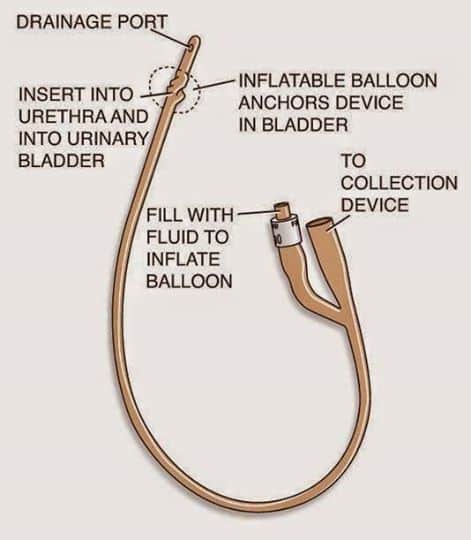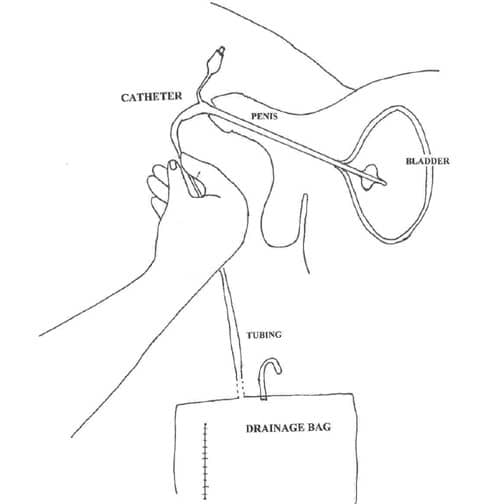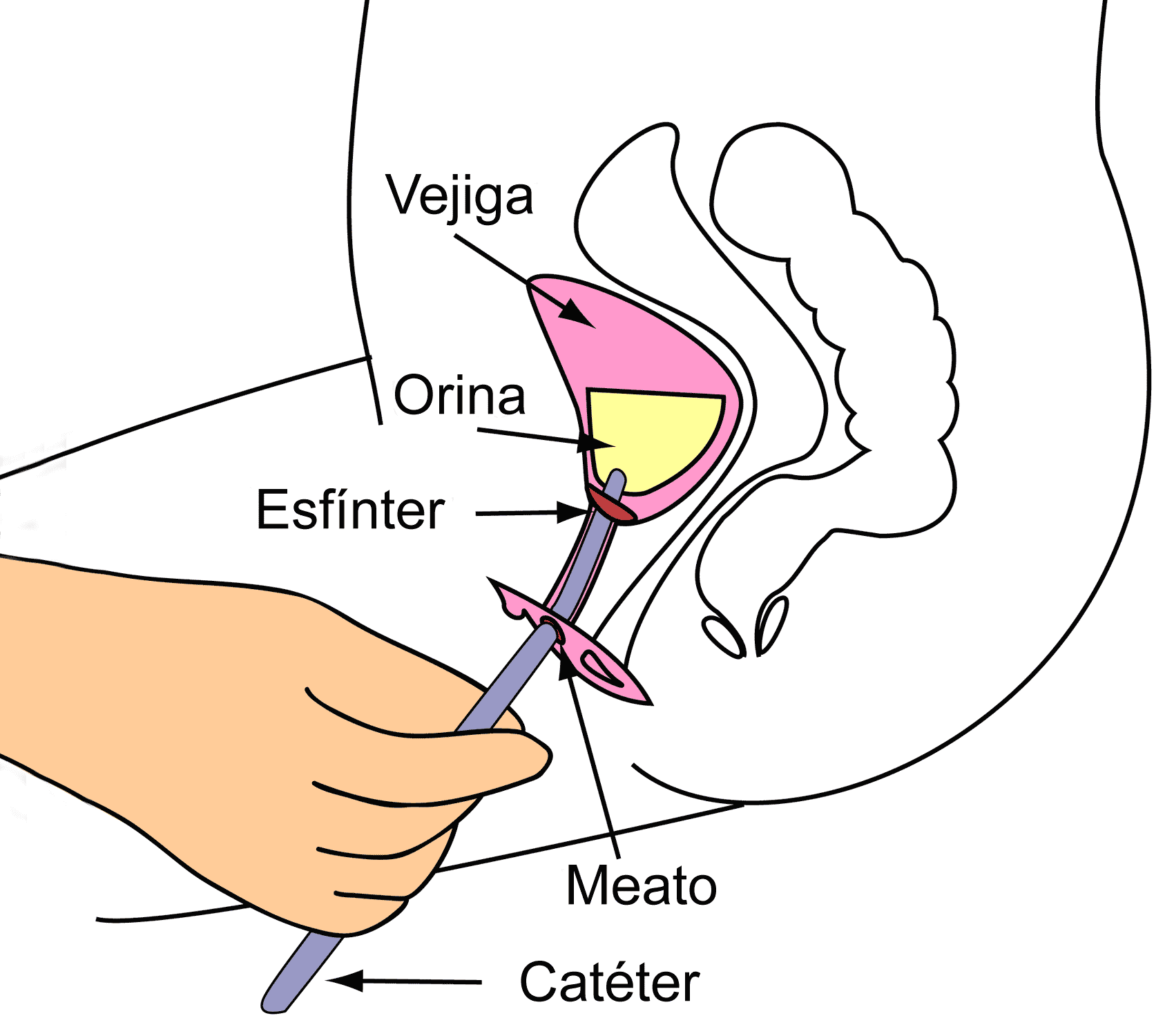How Does A Catheter Work
Originally published on: June 25th, 2020. Last modified on December 15th, 2021
A catheter drains urine from the bladder into a drainage bag which may be supported at thigh or calf level. The leg drainage bag requires changing every 5 to 7 days depending on manufacturers instructions.
A Belly Bag or a catheter valve may be recommended. Your District Nurse or Continence Advisor will advise you on which type may be appropriate for your needs.
If you do use a leg drainage bag then it requires emptying when it is half to three-quarters full. Always ensure it does not pull on the catheter.
The bags are usually of 350ml, 500ml, 750ml or 1litre capacity for daytime use . At night an extra 2-litre bag can be fitted easily to the day leg bag to increase the available capacity. These larger night bags mean you dont have to get up in the night to empty the bag. They should be supported on a catheter drainage bag stand.
What Happens If You Dont Empty A Catheter Bag
Failure to empty can lead to damaging overdistension of the bladder and back pressure on the kidneys. Stagnant urine becomes infected and in a damaged bladder this can readily lead to serious even life-threatening consequences for the patient.
Failure to store presents distressing and humiliating incontinence not only causing many older people to seek residential care but also raising the risk of skin maceration and ulceration. Monitoring urinary output in the unconscious patient whether under anaesthetic or coma provides the clinician with vital evidence about their condition.
Under any of these circumstances, drainage of the bladder to collect the urine becomes a vital aspect of patient care.
The modern catheter consists of a thin, flexible hollow tube made of silicone or of latex which will normally be coated. A wide variety of polymer coatings have been introduced in recent years to reduce friction by use of hydrogels which can provide a hydrophilic slippery surface and antimicrobials such as silver or antibiotics to counter the risk of urinary tract infections.
When Should I See My Doctor
Always see your doctor if you notice any blood in the urine or have symptoms of a urinary tract infection.
You should see your doctor or continence advisor if your catheter keeps getting blocked or if you have any pain due to your catheter.
Seek medical attention for any of the catheter problems mentioned above that cannot be managed with simple self-care measures.
You May Like: Why Do I Have Urinary Incontinence
When An Internal Catheter Is More Appropriate
Condom catheters arent helpful if urine cant drain out of your bladder. In that case, an internal catheter is needed to bypass whatever is stopping the urine flow.
Conditions where an internal catheter is used include:
- Urinary retention. This condition prevents you from completely emptying your bladder.
- Neurogenic bladder. A nerve problem, like a spinal cord injury or multiple sclerosis, can also prevent your bladder from emptying.
- Urinary tract blockage.Bladder stones and urethral strictures can block urine flow.
Talking To Your Doctor About Using A Catheter For Men

Ask questions and go over your concerns with a licensed physician before agreeing to catheterization. Candidly discuss individual risks and benefits while youre in the office. See if there are pain relief medications that would be appropriate for your unique case.
TIP: Keep UTIs at bay by requesting low-dose antibiotics or topical ointment.
Recommended Reading: Urinary So Morsels In Gravy
How Can I Help Prevent An Infection
- Wash your hands: Always wash your hands with soap and water before you catheterize yourself.
- Clean and dry reusable catheters: Clean all reusable catheters with soap and warm water after every use. Sterilize all reusable catheters in a pan of boiling water for 20 minutes. Set the catheters on a clean paper towel to dry.
- Store catheters correctly: Store dry catheters in a clean plastic bag. Throw away torn, hardened, or cracked catheters.
- Wear cotton boxers or underwear: These allow airflow and keep your genital area dry.
- Drink plenty of liquids: Ask your healthcare provider how much liquid to drink each day and which liquids are best for you. This helps to keep you from getting a urinary infection.
Why Might I Need To Use A Catheter
There are many reasons why you may need to have a catheter. Some reasons include:
- bladder problems
- problems with the nerves controlling the bladder. For example, if you have a spinal injury
- urinary retention
- during labour and childbirth if an epidural has been used
- some types of bladder tests and treatments
- having certain types of surgery
- people who are very unwell in hospital
You May Like: Do Urinary Tract Infections Make You Tired
Risks Of A Urinary Catheter
The primary risk of short-term catheterization is a urinary tract infection. In addition, the urethra can become irritated. The skin surrounding the insertion site might also be injured and should be inspected regularly for signs of breakdown.
In rare cases, a urinary tract infection can lead to urosepsis, a systemic infection that can be very serious.
Purpose Of A Urinary Catheter
A urinary catheter is used when the patient is unable to control their bladder because of illness, incontinence, a condition that makes urination difficult , or unconsciousness.
For example, a catheter is often placed at the beginning of certain surgeries because the patient will not be conscious for the procedure. Without the catheter, the patient might urinate during the procedure and potentially contaminate the sterile field, or their bladder may become distended with urine during a long procedure.
To prevent infections, catheters are used only when necessary. In hospitalized patients, intensive care patients typically have a catheter in place for longer than a day. For other patients who have one in place, the catheter is removed as soon as they are conscious or well enough to urinate independently.
Urinary retention is an issue where the bladder fails to empty completely. Depending on the severity of the issue, a temporary catheter, called a straight catheter, may be used to drain the bladder.
Read Also: Azo Urinary Tract Defense Instructions
Urinary Catheter Side Effects
There are a few things to watch for when you use urinary catheters other than external and condom catheters.
Infection. This is the most common problem. The catheter may let germs into your body, where they can cause an infection of your bladder, urethra, urinary tract, or kidneys. Call your doctor if you:
Leaks. This may be a sign that your catheter is blocked by clotted blood or debris. Tell your doctor if you see blood clots in your urine or you think something is blocking the flow of urine.
Bladder spasms. These can happen if your bladder tries to push out the catheter. Medicine can help.
Other, less common side effects are:
External Or Condom Catheters
Finally, we have the external or condom catheters for men who experience urinary incontinence.
Unlike the two previous types weve discussed, an external catheter doesnt have a tube that goes into the bladder. Instead, the man wears a condom-like device with a tube attached to the tip. The tube is then connected to a drainage bag that can be secured to the leg. Whenever the man experiences urine leakage due to incontinence, the urine will flow through the tube and into the bag.
Also Check: Urinary Tract Infection Or Kidney Stone
Looking After Your Catheter
If you need a long-term urinary catheter, you’ll be given detailed advice about looking after it before you leave hospital.
This will include advice about getting new catheter supplies, reducing the risk of complications such as infections, spotting signs of potential problems, and when you should get medical advice.
You should be able to live a relatively normal life with a urinary catheter. The catheter and bag can be concealed under clothes, and you should be able to do most everyday activities, including working, exercising, swimming and having sex.
Read more about living with a urinary catheter.
A Look A What’s A Catheter How They Work And What They Are Used For

A urinary catheter is a soft hollow tube, which is passed into the bladder to drain urine. Catheters are sometimes necessary for people, who for a variety of reasons, cannot empty their bladder in the usual way, i.e. passing urine into a toilet or urinal.
Indwelling catheters are usually required short term for a number of weeks or months when continuous bladder drainage is needed, but occasionally they are required for long-term use.
Catheters are manufactured in a variety of materials, which mean they can be left in place for many weeks.
Once inserted a small balloon device is inflated, which prevents the catheter from falling out. On no account must you try to remove the catheter without the balloon being fully deflated. If you have a problem with your catheter seek help immediately.
Read Also: Foods For Healthy Urinary Tract
Male & Female Lower Urinary Tract
The lower urinary tract is the term used to describe the bladder and urethra, whereas the upper urinary tract refers to the kidneys and ureters.
Catheterisation of the bladder has been performed since time immemorial to drain urine from the bladder when it fails to empty. The bladder acts as a temporary reservoir for urine on its passage out of the body through the urethra. About 1500 ml of urine a day are produced, containing soluble waste products filtered by the kidneys from the bloodstream.
When Urinary Catheters Are Used
A urinary catheter is usually used when people have difficulty peeing naturally. It can also be used to empty the bladder before or after surgery and to help perform certain tests.
Specific reasons a urinary catheter may be used include:
- to allow urine to drain if you have an obstruction in the tube that carries urine out of your bladder . For example, because of scarring or prostate enlargement
- to allow you to urinate if you have bladder weakness or nerve damage that affects your ability to pee
- to drain your bladder during childbirth if you have an epidural anaesthetic
- to drain your bladder before, during or after some types of surgery
- to deliver medicine directly into the bladder, such as during chemotherapy for bladder cancer
- as a last resort treatment for urinary incontinence when other types of treatment have been unsuccessful
Depending on the type of catheter you have and why it’s being used, the catheter may be removed after a few minutes, hours or days, or it may be needed for the long term.
Also Check: How To Control Urinary Incontinence
How To Insert A Catheter
This article was medically reviewed by Sarah Gehrke, RN, MS. Sarah Gehrke is a Registered Nurse and Licensed Massage Therapist in Texas. Sarah has over 10 years of experience teaching and practicing phlebotomy and intravenous therapy using physical, psychological, and emotional support. She received her Massage Therapist License from the Amarillo Massage Therapy Institute in 2008 and a M.S. in Nursing from the University of Phoenix in 2013.There are 9 references cited in this article, which can be found at the bottom of the page.wikiHow marks an article as reader-approved once it receives enough positive feedback. This article received 28 testimonials and 87% of readers who voted found it helpful, earning it our reader-approved status. This article has been viewed 927,862 times.
What Can I Do If Problems Develop
- No urine is draining into the bag:
- Check for kinks in the tubing and straighten them out.
- Check the tape or strap used to secure the catheter tube to your skin. Make sure it is not blocking the tube.
- Make sure you are not sitting or lying on the tubing.
- Make sure the urine bag is hanging below the level of your waist.
Recommended Reading: Urinary Tract Infection Sepsis Symptoms
What Is A Urinary Catheter And What Is Used For
Urinary catheters are a common aid to empty the bladder. The catheter consists of a flexible small thin tube that allows urine to leave the bladder. Some catheters also provide an integrated bag to collect the evacuated urine. Catheters can be used for many different reasons, both for temporary and long-term use. The most frequent reasons that lead to practicing catheterization are:
- Urine retention, that is the difficulty to completely empty the bladder
- Urinary incontinence, which is the involuntary loss of urine
- Surgical interventions
In all cases where the process of evacuating the urine is prevented by a lack of muscle contraction, anatomical and/or functional obstacles of the urethra, long-term catheterization will be necessary.
Enhancing Healthcare Team Outcomes
A myriad of clinical conditions may require bladder catheterization. While a physician or a nurse can place the catheter in most cases, consultation with urology is necessary for specific patients. The nurses are essential members of the interprofessional group, as they will predominantly perform the procedure. They also monitor the catheter and assist with the education of the patient and family as needed. The pharmacist will ensure that the patient is not on any medication that can precipitate urinary retention. The physical therapist also plays a role in early mobilization, voiding exercises, and rehabilitation. Interprofessional communication and care coordination among health professionals are vital to enhancing patient-centered care and improve outcomes.
Read Also: Natural Remedies For Male Urinary Tract Infection
How Long Can A Catheter Stay In
Several factors determine how long a catheter for men can stay in place. For one, the materials play a huge role in how your body reacts. Additionally, the cleanliness of the area is massively important for preventing infections and tubing blockages. Proper care can help support and prolong the treatments effectiveness.
DID YOU KNOW: The average man wears a catheter for between 2 and 12 weeks.
Different Types Of Urinary Catheterisation

The two main types of urinary catheter are:
- indwelling catheter inserted through the urethra, or through the wall of the stomach, into the bladder and left in place for a period of time
- intermittent catheter inserted through the urethra into the bladder to empty it, then removed, several times a day.
You May Like: Purina One For Urinary Tract Health
Risks And Potential Problems
The main problems caused by urinary catheters are infections in the urethra, bladder or, less commonly, the kidneys. These types of infection are known as urinary tract infections and usually need to be treated with antibiotics.
You can get a UTI from using either a short-term or a long-term catheter. However, the longer a catheter is used, the greater the risk of infection. This is why it’s important that catheters are inserted correctly, maintained properly, and only used for as long as necessary.
Catheters can also sometimes lead to other problems, such as bladder spasms , leakages, blockages, and damage to the urethra.
Read more about the risks of urinary catheterisation.
Page last reviewed: 26 February 2020 Next review due: 26 February 2023
How Do You Prepare For Foley Catheter Insertion
Keep the genital area clean. Switch to looser-fitting cotton clothing, and do not use chemical irritants in the genital area prior to having the catheter inserted.
- Male catheterization: The male urethra is long compared to the female urethra. A catheter is placed while lying down or in the frog-legged position. If there is a foreskin, it is retracted to its maximal limit.
- The doctor or medical assistant will insert the Foley catheter in this manner:
- The urethra and the surrounding areas are cleaned with a cotton-ball dipped in antiseptic solution. Beginning at the urethra, the cleansing is performed in a circular motion, moving outward to the surrounding areas.
- A Foley catheter, lubricated with water-soluble jelly, is inserted into the bladder through the urethra.
- Once the catheter is passed, the balloon is in the bladder. It is then slowly inflated with about 10cc of water using a syringe. Inflating the balloon should not be painful.
- At this time, urine, if present in the bladder, should flow back through the catheter and into the sterile drainage bag.
Also Check: Can Back Pain Cause Urinary Incontinence
Looking After Your Indwelling Catheter
- If you have an indwelling catheter its important to make sure your drainage bag is kept lower than your bladder, and make sure there are no kinks in the tubing this makes sure urine flows from your bladder into the drainage bag and not back up your urethra into your bladder. Its a good idea to empty your drainage bag regularly during the day so the weight of a full bag doesnt pull on the tube.
- Most people will be supplied with a bag to use during the day and a different one at night. Catheter bags can be cleaned each day and reused. Your health professional will let you know how often you need to use a new bag and will show you how to properly clean and dry the bags. Its important to follow the advice of your doctor or nurse to minimise your risk of infection.
- Indwelling catheters are usually changed every 612 weeks by your doctor or nurse.
Its possible to maintain your sex life with an indwelling catheter talk with your doctor or nurse about ways to manage this.